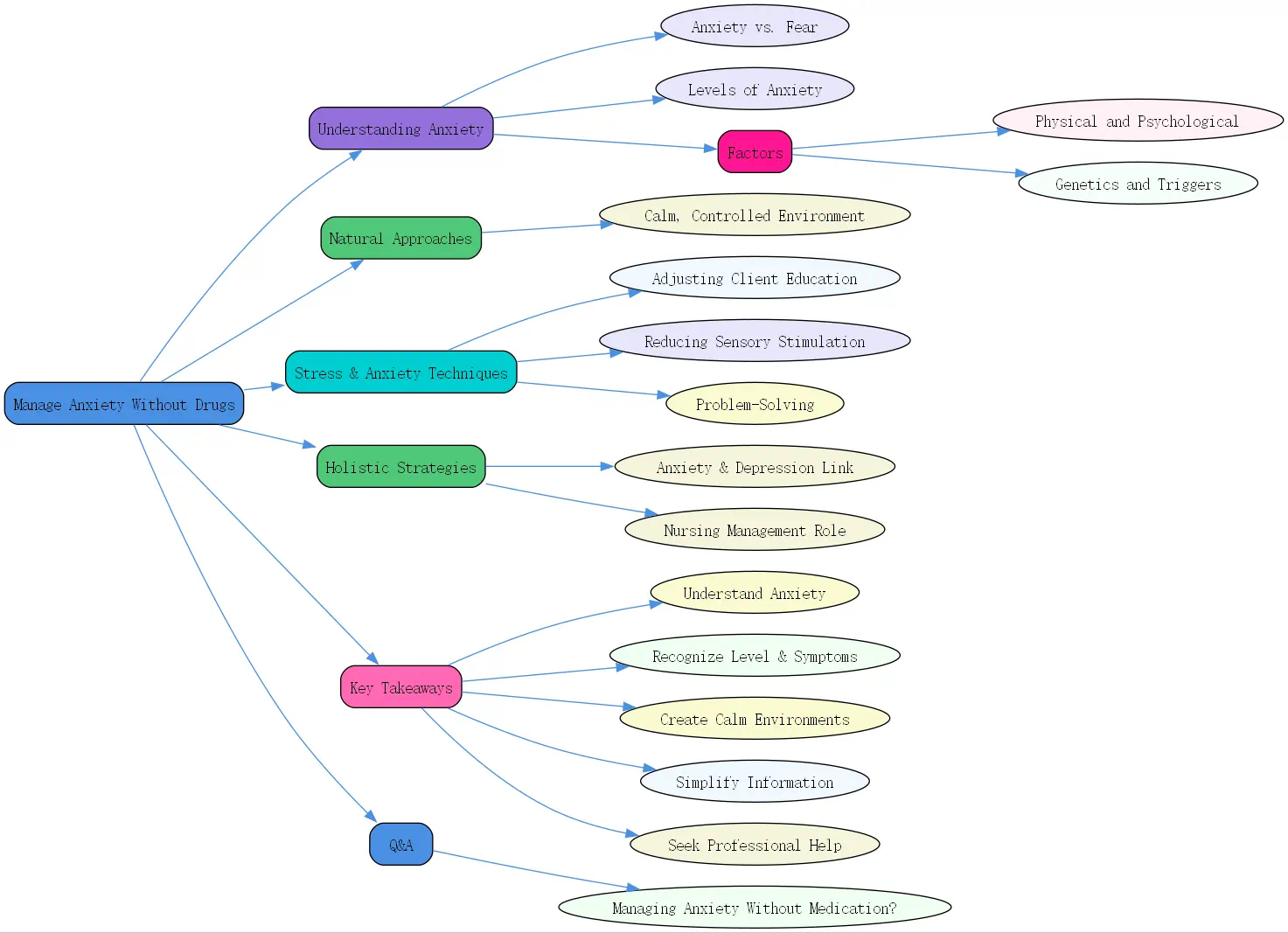Understanding Anxiety and Its Impact

Anxiety and fear are terms often used interchangeably in modern society, but they represent distinct psychological experiences. Anxiety can be defined as a vague, uneasy feeling that creates a sensation of nonspecific danger, putting us on high alert. Fear, on the other hand, is a feeling of terror produced by something specific that is perceived as dangerous or threatening.
It’s entirely human to feel anxious in unfamiliar environments or to fear pain, suffering, or death. Many people experiencing medical issues or undergoing surgical procedures feel vulnerable, making them more likely to experience heightened anxiety.
Defining Anxiety vs. Fear: Recognizing the Differences
The distinction between anxiety and fear is crucial for developing effective management strategies. While fear is a response to a clear and present danger, anxiety often lacks a specific trigger. This difference impacts how we approach treatment and self-management techniques.
“”Understanding whether you’re experiencing anxiety or fear is the first step toward effective management,”” explains BrainTalking’s lead psychologist. “”This distinction helps determine which coping strategies might work best for your specific situation.””
Levels of Anxiety: From Mild to Panic – Identifying the Stages
Anxiety exists on a spectrum, ranging from mild to panic levels. Each stage presents different symptoms and challenges:
Mild Anxiety: At this level, attention is slightly increased, perception expands, and focus on stimuli improves. Reality remains undistorted. Physical manifestations include slightly elevated heart rate and blood pressure, increased breathing, and noticeable perspiration.
Moderate Anxiety: The person becomes easily distracted with impaired concentration. Perception begins to narrow, and problem-solving becomes difficult. Physically, muscles tense, slight tremors may appear, speech patterns change, vital signs increase, and sleep may be disturbed.
Severe Anxiety: Attention span decreases dramatically, perception is severely reduced, and extreme discomfort is expressed. Controlling emotions requires significant effort. Physical symptoms include hyperventilation, dizziness, tachycardia, impaired fine motor movements, twitching, and limited communication.
Panic Level: At this extreme stage, perception becomes totally distorted, learning abilities are disabled, thought processes fragment, and emotional control is lost. The person feels helpless, speech becomes incoherent, movements are distorted, and there may be attempts to escape. Physical manifestations include fainting, tremors, and profuse perspiration.
Physical and Psychological Factors Contributing to Anxiety
Anxiety disorders develop through a complex interplay of physical and psychological factors. The ongoing debate about whether anxiety stems from biological issues, learned responses, or unconscious emotional conflicts often concludes that it’s a combination of all three.
Research indicates that both physical and psychological factors contribute to anxiety disorders. This multifaceted understanding helps explain why some management approaches work better for certain individuals than others.
The Role of Genetics and Triggers in Anxiety Disorders
Current understanding suggests that individuals need to be genetically predisposed to anxiety to develop an anxiety disorder when exposed to specific triggers. This genetic component explains why anxiety disorders often run in families.
However, genetic predisposition alone isn’t enough – environmental triggers play a crucial role in activating these predispositions. This understanding forms the foundation for many approaches to manage anxiety without drugs, focusing on trigger identification and management.
Managing Anxiety Without Medication: Natural Approaches
Contrary to popular belief, anxiety isn’t always a condition to be avoided. Mild anxiety can be constructive, motivating appropriate actions in certain situations – like studying before an exam. However, more extensive anxiety can interfere with well-being, necessitating management strategies.
Creating a Calm and Controlled Environment
One of the most effective ways to manage anxiety without drugs involves creating an environment conducive to calm and control. This approach focuses on external factors that can either exacerbate or alleviate anxiety symptoms.
Building Trust and Therapeutic Relationships
Trust forms the critical foundation of any therapeutic relationship, especially when dealing with anxiety. For those supporting anxious individuals, being available and attentive to their needs is essential. Avoiding leaving an anxious person alone during frightening experiences prevents feelings of abandonment that can escalate anxiety to more destructive levels.
“”The presence of a trusted individual can significantly reduce anxiety levels,”” notes BrainTalking’s research. “”This human connection provides a sense of safety that medication alone cannot replicate.””

Restoring Comfort: Practical Techniques for Immediate Relief
When working to manage anxiety without medication, restoring comfort becomes paramount. This involves asking the anxious person what would make them feel more comfortable. Some individuals find support through nonverbal means – having someone present without talking, holding their hand, or offering gentle touch.
Others prefer discussing their feelings but may feel more relaxed with physical distance. Understanding personal comfort levels regarding physical proximity and communication style is crucial for effective anxiety management.
Modifying Communication: Effective Strategies for Anxious Individuals
Communication modification plays a vital role in anxiety management. Avoiding interrupting anxious individuals when they speak is crucial, as verbalization can help process information and explore coping methods. For those unwilling to discuss their anxiety, respecting their privacy while offering referrals to mental health professionals may be appropriate.
Practical Techniques for Stress and Anxiety Management
Beyond environmental adjustments, specific techniques can help manage stress and anxiety without relying on medication.
Adjusting Client Education: Simplifying Information for Better Comprehension
Anxiety limits attention and concentration, necessitating simple, brief directions and explanations. Frequent repetition ensures information retention. Determining comprehension through “”repeat back”” methods helps confirm understanding and identifies areas needing clarification.
This approach recognizes that anxiety affects cognitive processing and adapts information delivery accordingly. By simplifying complex information, anxious individuals can better absorb and implement management strategies.
Reducing Sensory Stimulation: Creating a Peaceful Atmosphere
For anxious individuals, reducing sensory stimulation can provide significant relief. This might involve dimming lights, eliminating noise, or minimizing interruptions. Creating a peaceful atmosphere helps lower the physiological arousal associated with anxiety.
This technique works by decreasing the overall stimulation that the nervous system must process, allowing the body’s natural calming mechanisms to function more effectively – a key component of strategies to manage anxiety without drugs.
Problem-Solving Strategies: A Step-by-Step Guide
Anxiety impairs problem-solving abilities, often leading individuals to seek external advice. Rather than influencing decisions, teaching a step-by-step problem-solving process empowers anxious individuals to make their own choices:
1. Identify the problem 2. Determine the cause 3. Explore possible solutions 4. Define pros and cons for each solution 5. Select the choice most compatible with personal values
This structured approach provides a framework that helps overcome the cognitive challenges anxiety creates, fostering independence and confidence.
Ensuring Safety During Panic Attacks
For individuals experiencing panic-level anxiety, safety becomes the primary concern. Those in extreme anxiety states may act impulsively, potentially endangering themselves. Maintaining calm around them helps reduce their anxiety to more manageable levels.
Having only one person interact with someone experiencing a panic attack prevents multiple stimulation sources that could increase agitation. For unstable clients, avoiding touching or getting physically close without permission prevents perceived intrusions that might escalate anxiety.
Anxiety and Depression Management: Holistic Strategies
Anxiety disorders often coexist with depression, requiring comprehensive management approaches. Holistic strategies address both conditions simultaneously, recognizing their interconnected nature.
The Importance of Nursing Management for Anxious Clients
Professional support plays a crucial role in anxiety management. Nursing management focuses on maintaining or restoring a sense of calm and control, helping individuals develop sustainable coping mechanisms.
Assessing Client’s Learning Style and Comprehension Level
Effective anxiety management requires tailoring approaches to individual learning styles and comprehension levels. This personalized approach ensures that management techniques align with the person’s capabilities and preferences.
Assessment must determine not only learning style but also current comprehension abilities, which may be temporarily impaired by anxiety. Information delivery must adapt accordingly, with small, repeated segments replacing comprehensive explanations.
Offering Referrals to Mental Health Professionals
While many anxiety management techniques can be self-implemented, some situations require professional intervention. Offering referrals to psychiatrists, psychologists, or medical social workers provides access to specialized expertise.
This approach recognizes the limitations of self-management and ensures individuals receive appropriate care when needed. Professional support complements self-management strategies, creating a comprehensive approach to anxiety management.
Understanding Anxiety Disorders

Anxiety disorders represent a group of psychobiological illnesses generated by activation of the autonomic nervous system, particularly the sympathetic “”fight-or-flight”” division. These conditions tend to be chronic and sometimes appear without logical explanation.
Defining Anxiety Disorders: A Psychobiological Perspective
From a psychobiological perspective, anxiety disorders involve dysregulation of the body’s stress response systems. This understanding helps explain why management approaches must address both psychological and physiological aspects of anxiety.
Common Types of Anxiety Disorders
Anxiety disorders encompass various conditions, including generalized anxiety disorder, panic disorder, social anxiety disorder, and specific phobias. Each type presents unique challenges and may respond differently to management strategies.
Understanding the specific type of anxiety disorder helps tailor management approaches for maximum effectiveness. While general anxiety management techniques apply broadly, some strategies work better for specific anxiety disorders.
Key Takeaways for Managing Anxiety Without Drugs
- Understand the difference between normal anxiety and anxiety disorders
- Recognize your personal anxiety level and corresponding symptoms
- Create environments that promote calm and reduce stimulation
- Implement step-by-step problem-solving techniques
- Simplify information processing during anxious states
- Build trusted relationships for support during anxiety episodes
- Seek professional help when self-management proves insufficient
Q&A Section

Q: Can anxiety be completely managed without medication?
A: For many individuals, anxiety can be effectively managed without medication through techniques like cognitive-behavioral therapy, mindfulness practices, regular exercise, and stress reduction strategies. However, the effectiveness of non-medication approaches varies based on anxiety severity, type, and individual factors. Some people with severe anxiety disorders may benefit from a combination of medication and non-pharmacological approaches. The goal should be finding the most effective management strategy for your specific situation, which might include medication for some periods or completely medication-free approaches for others. Always consult with healthcare professionals before making decisions about anxiety treatment approaches.




